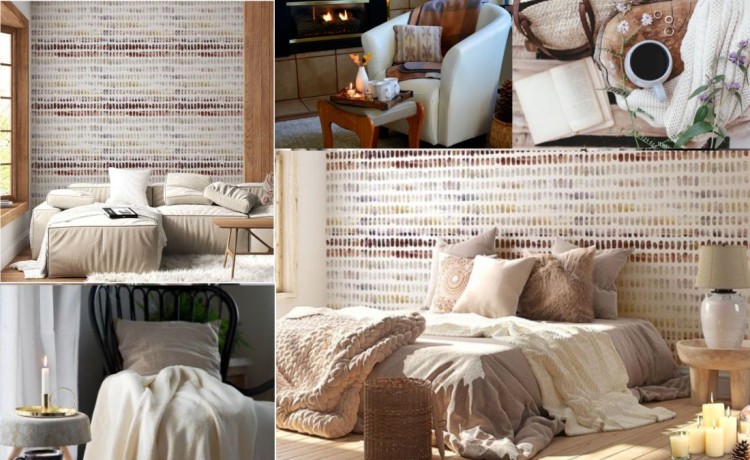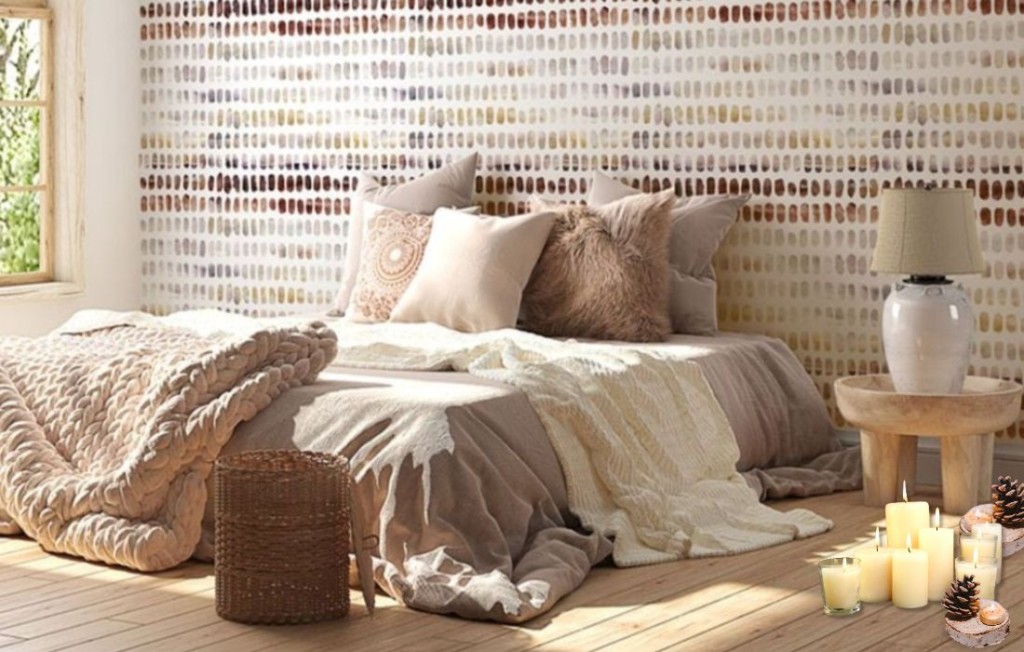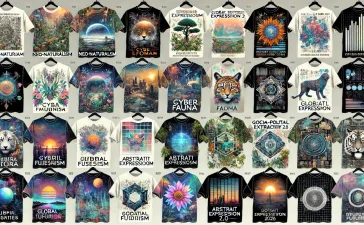Hygge (pronounced “hoo-gah”) has become a global design phenomenon in recent years, but it’s far more than just an aesthetic trend. Rooted in Danish culture, hygge is a lifestyle concept that focuses on creating cozy, inviting spaces that promote a sense of warmth, comfort, and well-being. For artists, surface designers, art directors, and manufacturers, this design style offers rich opportunities to create products and spaces that resonate with consumers’ growing desire for comfort, connection, and simplicity.
In this article, we will explore the origins of hygge design, what makes it so appealing, why it’s trending, and how creatives can incorporate hygge into their work. Whether you’re designing home décor, textiles, or packaging, hygge offers a timeless, universally appealing approach to design.
What Is Hygge Design?
Hygge is a Danish concept that roughly translates to “coziness” or “contentment.” It embodies a feeling of well-being and comfort, particularly during the colder months when people seek solace in their homes. Hygge encourages us to slow down, enjoy the small moments, and focus on creating intimate, warm spaces where we can relax, connect, and feel secure.
In terms of design, hygge is all about simplicity, warmth, and minimalism. It typically incorporates neutral colour palettes, soft lighting, natural textures, and simple, functional furniture. The goal is to create an atmosphere that feels both welcoming and serene, allowing people to unwind and recharge.
Key elements of hygge design include:
- Soft, cozy textiles like wool blankets, knitted throws, and plush cushions.
- Natural materials such as wood, stone, and leather.
- Warm, neutral colour palettes featuring whites, greys, beiges, and earthy tones.
- Ambient lighting from candles, lanterns, or low-wattage bulbs.
- Minimalist, functional décor that emphasizes quality over quantity.
The hygge aesthetic is not about extravagance or opulence. Instead, it’s about finding beauty in simplicity and functionality—something that resonates deeply with today’s design-conscious consumers who are seeking both comfort and sustainability.
The Origins of Hygge
The term “hygge” originates from the Old Norse word “hugga,” which means to comfort or console. While the word has been used in Denmark and Norway for centuries, it has recently gained international popularity, particularly in the design world.
Hygge became particularly significant in Denmark, a country known for its long, dark winters. The Danish people developed hygge as a way to make those cold months more bearable by creating warm, comforting environments inside their homes. Over time, hygge has become a key aspect of Danish culture, symbolizing not just physical comfort but also emotional well-being and social connection.
Today, hygge has transcended Danish borders and has become a global trend, especially in interior design, where the focus is on creating serene, functional, and inviting spaces. It’s also closely related to other Scandinavian design principles, such as lagom (Swedish for “just the right amount”) and friluftsliv (Norwegian for “open-air living”), which all emphasize a balanced, thoughtful approach to life and design.
Why Hygge Design is Trending
The popularity of hygge design has exploded in recent years, and for good reason. In an increasingly fast-paced, digitally driven world, many people are looking for ways to slow down and create more meaningful, comfortable environments. Hygge taps into a broader cultural shift toward wellness, mindfulness, and simplicity.
Several factors have contributed to the rise of hygge-inspired design:
- The wellness movement: As people become more focused on mental health and well-being, they are seeking out environments that promote relaxation, comfort, and calm. Hygge design helps create spaces that feel like sanctuaries from the stresses of daily life.
- Sustainability: Hygge’s focus on natural materials and minimalism aligns with the growing demand for sustainable, eco-friendly products. By emphasizing quality over quantity, hygge encourages consumers to choose well-made, long-lasting items.
- The work-from-home revolution: With more people working from home, there’s an increased interest in designing spaces that are both functional and cozy. Hygge offers a way to create work environments that are conducive to productivity while also providing comfort and relaxation.
- The desire for connection: Hygge is not just about creating physical warmth, but also fostering emotional connections. It emphasizes the importance of spending time with loved ones, whether through sharing meals, playing games, or simply relaxing together.
For artists, surface designers, art directors, and manufacturers, the trend toward hygge represents a significant opportunity to create products that appeal to consumers seeking both comfort and mindfulness.
Artisan Stone_Wallpaper by SIllier Than Sally for Big Kid Co. Availble in Bunnings Marketplace
Applying Hygge-Inspired Designs to Your Work
Now that we’ve explored the origins and appeal of hygge design, let’s discuss how you, as a creative professional, can incorporate these principles into your work. Whether you’re designing textiles, home décor, or furniture, hygge offers a versatile and timeless approach that resonates with today’s consumers.
1. Use Natural Materials and Textures
Hygge design is deeply rooted in nature, so one of the easiest ways to create a hygge-inspired product is to incorporate natural materials. Think wood, wool, cotton, stone, and leather. For surface designers, this could mean creating fabric patterns that mimic these textures or using them directly in your products.
For manufacturers, focus on producing items like wooden furniture, wool throws, or linen cushions. Natural materials not only evoke warmth and coziness, but they also appeal to consumers’ increasing interest in sustainability and eco-friendly products.
2. Opt for a Warm, Neutral Color Palette
Hygge design tends to feature soft, muted colours that create a calming atmosphere. Whites, greys, beiges, and soft browns dominate hygge spaces, with occasional accents of warm tones like rust, deep green, or soft blush.
Artists and surface designers can incorporate these colours into their work, whether through textiles, wallpaper, or home accessories. Keep in mind that simplicity is key—hygge designs often avoid bold, bright colours in favour of more understated tones that contribute to a sense of calm.
3. Focus on Comfort and Functionality
Hygge is about creating environments that promote comfort and well-being, so prioritize comfort and functionality in your designs. For example, if you’re designing furniture, think about how the piece can serve both a functional and aesthetic purpose. Can a sofa be both stylish and incredibly cozy? Can a throw blanket be both a decorative accent and a source of warmth?
For surface designers, think about creating patterns that evoke comfort—soft, flowing designs like organic shapes, minimalist florals, or hand-drawn elements that feel personal and inviting.
4. Emphasize Minimalism
One of the core principles of hygge is simplicity. Hygge spaces are typically uncluttered, with a focus on quality over quantity. For artists and designers, this means avoiding overly complicated patterns or designs. Instead, opt for clean lines, simple shapes, and uncluttered compositions.
Incorporating minimalist elements doesn’t mean your designs have to be boring—hygge is all about finding beauty in simplicity. For example, a pattern featuring a few well-placed botanical illustrations can evoke a sense of calm and serenity.
5. Incorporate Lighting into Design
Lighting is a critical element of hygge. Soft, warm lighting creates the cozy atmosphere that defines hygge spaces. Designers can create lamps, candleholders, or lanterns that enhance this effect. For surface designers, consider how your patterns might be used on lighting accessories, such as lampshades or candleholders.
Ambient lighting, like candles or low-wattage bulbs, can also be incorporated into product photography and marketing materials to emphasize the hygge aesthetic.
Conclusion
Hygge-inspired design is much more than a fleeting trend; it’s a design philosophy rooted in warmth, comfort, and mindfulness. For artists, surface designers, art directors, and manufacturers, hygge offers an opportunity to create products that not only look beautiful but also resonate with consumers’ growing desire for wellness and connection.
By embracing the principles of hygge—natural materials, warm colours, simplicity, and functionality—creatives can design spaces and products that foster a sense of well-being and tranquility. As the demand for hygge-inspired products continues to grow, those who master the art of cozy, thoughtful design will find themselves well-positioned for success.
- Find out more
- Launch Pad + Accelerator Expressions of Interest
- Selling and Licensing Your Art & Designs Around the World with ArtSHINE.
- Looking for exciting new Art and Designs to license.
We’re here to help you to take action, just like we’ve helped thousands of other entrepreneurs, business owners, and creative professionals all around the globe.
Now is the time to let your passion SHINE.
Now is the time to Make Tomorrow Today!
To your success, Vinh Van Lam and Stuart Horrex Cofounders ArtSHINE.com







